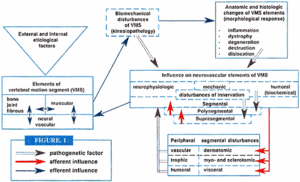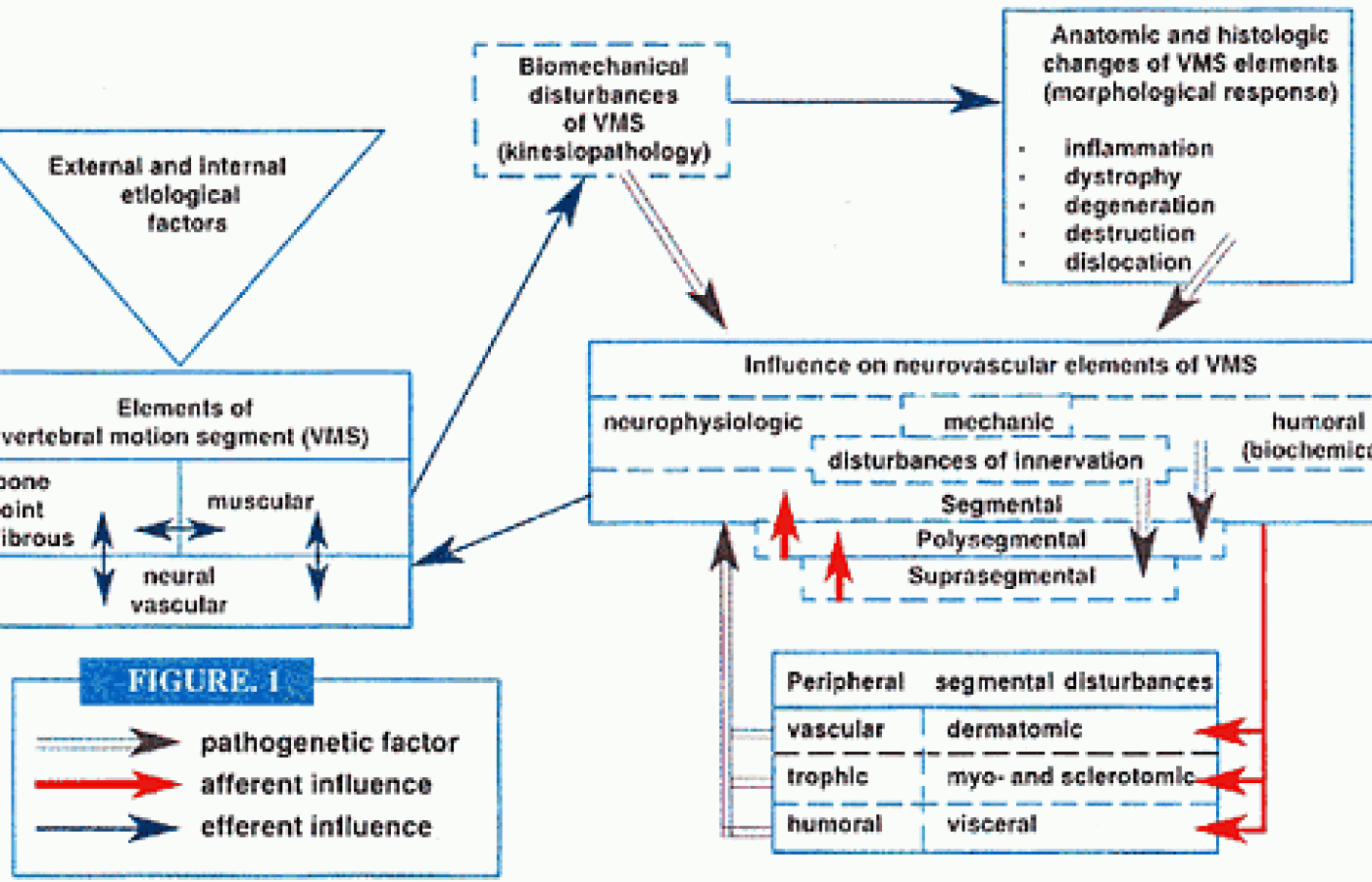Recent laws in New Jersey and California represent a disturbing trend that will negatively impact a practice’s ability to collect monies from patients, as well as expose them to significant penalties if the practice does not follow the mandatory guidelines to a T. Please be aware that a similar law may be coming to your state. The time to act is before the law is passed.
A Vertebrosegmental Philosophy for Chiropractic
I have my medical degree from Russia and knew nothing about chiropractic when I started to work with Cleveland Chiropractic College in early 1993. Though my medical education included training in spinal manipulation, I still had to attend classes to study chiropractic philosophy. After learning the history and development of chiropractic, as well as noting current advances in research and philosophy, it seemed natural to ask, "Why not implement theories known to me from manipulative medicine into chiropractic?" Through discussion, I came to understand that it is not necessary to "change"; rather, the mutually beneficial approach is to share and develop. This article is an effort to present one school of thought in manipulative medicine: vertebrosegmental methodology.
Vertebrosegmental methodology (VSM) is, like chiropractic, based on the general precepts of anatomy, physiology and pathology. Special emphasis is given to homeostasis and regulatory mechanisms. It is accepted that optimal homeostasis depends upon numerous unified and interdependent regulatory actions within the organism. This multilevel system of regulatory mechanisms developed during the evolutionary process to realize this unity. The structural and functional composition of this system includes segmental, multisegmental, intersegmental, and suprasegmental levels of homeostatic regulation.1-5
The segmental level is basic to the function of all levels of the system. Every regulatory act, including the most developed, begins afferently at the segmental level. Likewise, the efferent part of the regulatory cycle ends at the segmental level. Thus, the phylogenetic role of the segmental apparatus is as a major link between the external and internal factors influencing homeostasis.
The apparatus of segmental regulation consists of the following structural and functional elements (see Figure I):

- spinal motion segment (SMS): It joins segments of the spinal cord and bone, joint, muscular, fibrosal, neural, vessel elements of vertebrae which have phylogenetical, anatomical and functional connections with spinal segments. We understand here that "segment of spinal cord" is a conditional definition, as "segment" doesn't have strict anatomical borders, and the spinal cord itself is much more complex than just a collection of "segments."
- para- and prevertebral centers of autonomic innervation;
- afferent and efferent pathways;
- segmental zones of somatic and autonomic innervation (dermatomic, sclerotomic, myotonic, visceral), which have an embryological connection with elements of skin, musculoskeletal system and internal organs.
On the basis of the proposed structural and functional model of the segmental apparatus, the following methodological principles of spinal manipulation could be formulated:
1. The reaction of the whole body to biomechanical disturbances at the region of SMS (subluxation, spondylosis, dystrophic and degenerative spine/disk disease, etc.) is not finished at this concrete SMS. In response to such disturbances, a natural, inevitable neurophysiological system of mechanisms is set in motion. This system is a combination of "vertical" and "horizontal" connections between musculoskeletal, visceral, humoral and psychological adaptative and regulatory mechanisms. The basic task of these mechanisms is to normalize physical and psychological homeostasis of the organism in response to changed conditions of life activity.6-9,12. Figure II is a conceptual model of the body's reaction to biomechanical changes at the SMS region.
Elements of vertebral motion segment
bone
joint
neurovascular spinal elements
central and peripheral element
of humoral regulation
Static and dynamic
disturbances of VMS
Structural and anatomic
disturbances of VMS
Vertebrospinal Conflict
Irritation ofspinal elements
Reflex
Mechanical
Disturbances of innervation
Suprasegmental
Polysegmental
Segmental
Disturbances in the
innervated zones
Dermatomic
Myo- and sclerotomic
Visceral
mainly primary vertebrogenous factor
mainly secondary vertebrogenous factor
humoral factor
2. Elaboration of effective technologies to diagnose and correct human health problems resultant from SMS requires an interdisciplinary synthesis of the achievements of all health care sciences. An example of such synthesis is the fruitful collaboration between manual medicine and different forms of acupuncture. Their efficacy as separate disciplines that treat both vertebrogenic disorders and internal organ diseases is well known today.6,9,10,21,22 The methodological union of the diagnostic and treatment approaches of these two disciplines with reference to vertebrosegmental problems is very powerful.
3. The focus of vertebrosegmental medicine is disturbance of homeostasis caused by initial or secondary biomechanical changes of SMS. In accordance with anatomical and physiological peculiarities of the segmental regulation of homeostasis, the complex of such disturbances could be described by vertebrosegmental conflict syndrome (see Figures 1 and 2). The vertebrosegmental conflict syndrome includes: disturbances of SMS, which have pathogenetical interconnections; disturbances of innervation; state and functioning of organs in certain segmental zones; and adaptational and homeostatic reactions of the whole body limited by mentioned disturbances.
4. Vertebrosegmental medicine employs visual, manual, instrumental and active motion procedures for the purpose of diagnosis. These procedures are used to demonstrate afferent, efferent and meridian symptoms of disturbances, which are caused by vertebrosegmental conflict. The above listed procedures have high diagnostic effectiveness during combined use because they cover the full pathogenetic spectrum of the basic unit of the integral homeostatic model, thus allowing objective evaluation of the state of biomechanical and neurophysiological factors with respect to segmental regulation of homeostasis.
5. Vertebrosegmental medicine uses the following therapeutic methods:
- manipulative (which is very similar to chiropractic) and instrumental methods of treatment of bone, joint, muscular and fibrosal elements of SMS and corresponding segmental zones;
- manual and instrumental influence on receptor's zones and biologically active skin points;
- restoration of physiological (or formation of compensatory) motion habits.
Treatment effect is based on common use of listed methods. It is also conditioned by purposeful correction of structural and biodynamic factors of vertebrosegmental conflict, as well as normalization of segmental neurophysiological and humoral mechanisms of homeostatic regulation.
Practical Considerations
- Vertebrosegmental medicine (VSM) justifies its practical necessity using similar principles to those of chiropractic. That is, there is widespread preclinical disturbance of SMS and this is connected to somatovisceral disease in much of the able-bodied population (subluxations, cartilage problems, etc., unresponsive to traditional medical treatment).
- VSM utilizes vertebrosegmental diagnosis (VSD) as its major diagnostic and prognostic tool. VSD has multiple areas of application including:
- medical selection of candidates for positions which have anthropometric, ergonomic and/or physical risks of vertebrogenic disturbances (pilots, drivers, dispatchers, "blue and white collar" workers, dock workers, loaders, production line workers, etc.);
- preventive screening of these workers and professionals;
- scientific investigations of ergonomic risk factors of vertebrogenic disturbances.
3. VSM treatment techniques might be called vertebrosegmental therapy (VST), which is also similar to chiropractic:
- treatment of workers and professionals mentioned above;
- non-drug ("physiological", "harmonic") healing (prolongation of longevity) of patients with neurologic and internal organ disturbances;
- scientific studies to create medical technologies aimed to support health and promote the well-being of different population groups depending on professional activity and/or environmental hazards.
Methods of VSD and VST are relatively "low-tech" and easy to learn by trained professionals. They are natural and physiological, and they exclude the use of expensive drugs and complex equipment for exhaustive correction of a number of health disturbances. Use of VSM methods in selection, insurance and medical support systems may decrease costs of treatment of preventable diseases, as well as temporary and permanent loss of capacity for work (premature disqualification, disability, etc.).
Acknowledgement
I wish to thank Dr. Ashley Cleveland for her assistance with the preparation of this manuscript.References
- Nozdrachev AD. Physiology of Vegetative Nervous System. Leningrad, 1983.
- Sandrigajlo LI. Anatomo-clinical Atlas of Neuropathology, 3rd edition. Minsk, 1978.
- Segment and reflex therapy. In: Big Medical Encyclopedia, 3rd edition. Moscow, 1979.
- Sinelnikov RD. Introduction to nervous system, organs of sense, and endocrine organs. Anatomy Atlas. Moscow, 1974.
- Kositzky GI (ed.) Human Physiology, 3rd edition. Moscow, 1985.
- Veselovsky VP. Practical Vertebroneurology and Manual Therapy. Riga, 1991.
- Popelyanski YU. Vertebrogenous Diseases of the Nervous System. Kazan, 1974.
- Umashev GS, Furman ME. Osteochondrosis of the Spine, 2nd edition. Moscow, 1984.
- Lewit K. Manuelle Medizin im Rahmen der Medizinische Rehabilitation, 3rd auff. Leipzig, 1978.
- Kasjan NA. Manual Therapy for the Osteochondrosis of the Spine. Moscow, 1985.
- Korzh AA, Hvisuk NI, Prodan AI. Manual therapy of the osteochondrosis of the spine: analytical literature review. Orthopedics and Trauma 1980;10:69-76.
- Syvak VV. Concept Modeling of Spine Osteochondrosis Development Aspects. Kiev, 1988.
- Satterhweit HS. Portable device for lumbar traction. US patent #4,907,575, 1990.
- Angelo RP. Apparatus for spinal decompression. US patent #4,838,250, 1989.
- Hayes L. Device to treat pain in cervical and/or lumbar spine. UK patent #2,203,348, 1988.
- Vertebrogenous Diseases of the Nervous System. Novokuzneztk, 1969.
- Petrov BG. Referred pain in abdominal disorders. In: Osteochondrosis of the Spine, part 1. Novokuznetzk, 1973, pp. 267-270.
- Okulov MM. Efficacy of manual therapy for the pathology of the internal organs. In: Manual Therapy in Vertebroneurology. Novokuznetzk, 1990, pp. 184-186.
- Manual therapy in gastrointestinal pathology. In: Manual Therapy in Vertebroneurology. Novokuznetzk, 1990, pp. 186-189.
- Davudov OV. Pathogenesis and treatment of vertebral abdominal syndrome. Clinical Medicine 1991;4:90-91.
- Gavaa L. Traditional and Contemporary Aspects of Eastern Reflexotherapy, 2nd edition. Moscow, 1990.
- Goidenko VS, Koteneva VM, Sitel AB. Neurology of Reflexotherapy. Moscow, 1982.
Andrei Pikalov, MD, PhD
Lee's Summit, Missouri
apikr@cyclops.pei.edu



